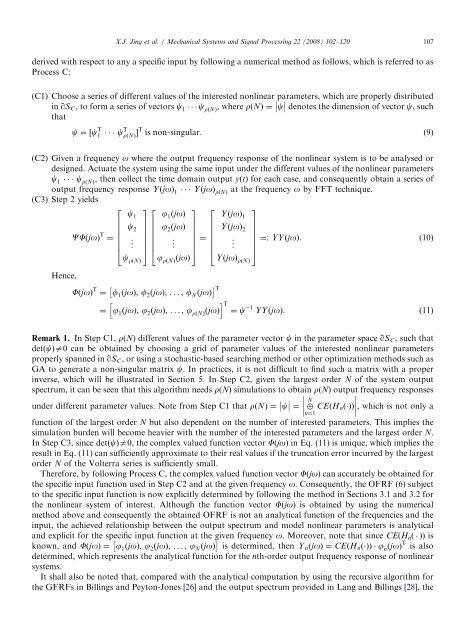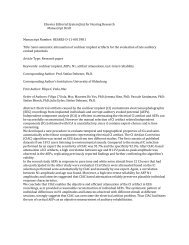Output frequency response function-based analysis for nonlinear ...
Output frequency response function-based analysis for nonlinear ...
Output frequency response function-based analysis for nonlinear ...
You also want an ePaper? Increase the reach of your titles
YUMPU automatically turns print PDFs into web optimized ePapers that Google loves.
derived with respect to any a specific input by following a numerical method as follows, which is referred to as<br />
Process C:<br />
(C1) Choose a series of different values of the interested <strong>nonlinear</strong> parameters, which are properly distributed<br />
in qSC, to <strong>for</strong>m a series of vectors c1 that<br />
crðNÞ, where rðNÞ ¼ c denotes the dimension of vector c, such<br />
c ¼½c T<br />
1 c T<br />
rðNÞŠT is non singular: (9)<br />
(C2) Given a <strong>frequency</strong> o where the output <strong>frequency</strong> <strong>response</strong> of the <strong>nonlinear</strong> system is to be analysed or<br />
designed. Actuate the system using the same input under the different values of the <strong>nonlinear</strong> parameters<br />
c1 crðNÞ, then collect the time domain output y(t) <strong>for</strong> each case, and consequently obtain a series of<br />
output <strong>frequency</strong> <strong>response</strong> YðjoÞ1 YðjoÞrðNÞ at the <strong>frequency</strong> o by FFT technique.<br />
(C3) Step 2 yields<br />
CFðjoÞ T 2 3 2 3 2 3<br />
c1 j1ðjoÞ YðjoÞ1 6 c<br />
7 6<br />
2 7 j<br />
7 6<br />
6 2ðjoÞ 7 YðjoÞ<br />
7<br />
6 2 7<br />
6 7 6 7 6 7<br />
¼ 6 . 7 6<br />
6<br />
4 . 7 . 7 ¼ 6<br />
6<br />
5 4 . 7 . 7 ¼: YYðjoÞ. (10)<br />
6<br />
5 4 . 7<br />
5<br />
crðNÞ jrðNÞðjoÞ YðjoÞrðNÞ Hence,<br />
ARTICLE IN PRESS<br />
X.J. Jing et al. / Mechanical Systems and Signal Processing 22 (2008) 102–120 107<br />
FðjoÞ T ¼ f1ðjoÞ; f2ðjoÞ; ...; fNðjoÞ T<br />
h iT ¼ j1ðjoÞ; j2ðjoÞ; ...; jrðNÞðjoÞ ¼ c 1 YYðjoÞ. ð11Þ<br />
Remark 1. In Step C1, r(N) different values of the parameter vector c in the parameter space qSC, such that<br />
detðcÞa0 can be obtained by choosing a grid of parameter values of the interested <strong>nonlinear</strong> parameters<br />
properly spanned in qSC, or using a stochastic-<strong>based</strong> searching method or other optimization methods such as<br />
GA to generate a non-singular matrix c. In practices, it is not difficult to find such a matrix with a proper<br />
inverse, which will be illustrated in Section 5. In Step C2, given the largest order N of the system output<br />
spectrum, it can be seen that this algorithm needs r(N) simulations to obtain r(N) output <strong>frequency</strong> <strong>response</strong>s<br />
under different parameter values. Note from Step C1 that rðNÞ ¼ c ¼ CEðHnð ÞÞ , which is not only a<br />
n¼1<br />
<strong>function</strong> of the largest order N but also dependent on the number of interested parameters. This implies the<br />
simulation burden will become heavier with the number of the interested parameters and the largest order N.<br />
In Step C3, since detðcÞa0, the complex valued <strong>function</strong> vector F(jo) in Eq. (11) is unique, which implies the<br />
result in Eq. (11) can sufficiently approximate to their real values if the truncation error incurred by the largest<br />
order N of the Volterra series is sufficiently small.<br />
There<strong>for</strong>e, by following Process C, the complex valued <strong>function</strong> vector F(jo) can accurately be obtained <strong>for</strong><br />
the specific input <strong>function</strong> used in Step C2 and at the given <strong>frequency</strong> o. Consequently, the OFRF (6) subject<br />
to the specific input <strong>function</strong> is now explicitly determined by following the method in Sections 3.1 and 3.2 <strong>for</strong><br />
the <strong>nonlinear</strong> system of interest. Although the <strong>function</strong> vector F(jo) is obtained by using the numerical<br />
method above and consequently the obtained OFRF is not an analytical <strong>function</strong> of the frequencies and the<br />
input, the achieved relationship between the output spectrum and model <strong>nonlinear</strong> parameters is analytical<br />
and explicit <strong>for</strong> the specific input <strong>function</strong> at the given <strong>frequency</strong> o. Moreover, note that since CE(Hn( )) is<br />
known, and FðjoÞ ¼ j1ðjoÞ; j2ðjoÞ; ...; jNðjoÞ is determined, then Y nðjoÞ ¼CEðHnð ÞÞ jnðjoÞ T is also<br />
determined, which represents the analytical <strong>function</strong> <strong>for</strong> the nth-order output <strong>frequency</strong> <strong>response</strong> of <strong>nonlinear</strong><br />
systems.<br />
It shall also be noted that, compared with the analytical computation by using the recursive algorithm <strong>for</strong><br />
the GFRFs in Billings and Peyton-Jones [26] and the output spectrum provided in Lang and Billings [28], the<br />
N

















